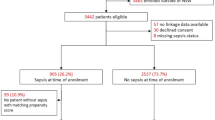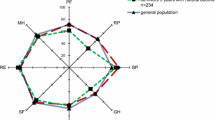Abstract
Purpose
In septic shock, short-term outcomes are frequently reported, while long-term outcomes are not. The aim of this study was to evaluate mortality and health-related quality of life (HRQOL) in survivors 6 months after an episode of septic shock.
Methods
This single-centre observational study was conducted in an intensive care unit in a university hospital. All patients with septic shock were included. Mortality was assessed 6 months after the onset of septic shock, and a comparison between patients who survived and those who died was performed. HRQOL was assessed using the MOS SF-36 questionnaire prior to hospital admission (baseline) and at 6 months in survivors. HRQOL at baseline and at 6 months were compared to the general French population, and HRQOL at baseline was compared to 6-month HRQOL.
Results
Ninety-six patients were included. Six-month mortality was 45 %. Survivors were significantly younger, had significantly lower lactate levels and SAPS II scores, required less renal support, received less frequent administration of corticosteroids, and had a longer length of hospital stay. At baseline (n = 39) and 6 months (n = 46), all of the components of the SF-36 questionnaire were significantly lower than those in the general population. Compared to baseline (n = 23), the Physical Component Score (CS) improved significantly at 6 months, the Mental CS did not differ.
Conclusions
Mortality 6 months after septic shock was high. HRQOL at baseline was impaired when compared to that of the general population. Although improvements were noted at 6 months, HRQOL remained lower than that in the general population.


Similar content being viewed by others
References
Alberti C, Brun-Buisson C, Burchardi H, Martin C, Goodman S, Artigas A, Sicignano A, Palazzo M, Moreno R, Boulme R, Lepage E, Le Gall R (2002) Epidemiology of sepsis and infection in ICU patients from an international multicentre cohort study. Intensive Care Med 28:108–121
Brun-Buisson C, Meshaka P, Pinton P, Vallet B (2004) EPISEPSIS: a reappraisal of the epidemiology and outcome of severe sepsis in French intensive care units. Intensive Care Med 30:580–588
Rivers E, Nguyen B, Havstad S, Ressler J, Muzzin A, Knoblich B, Peterson E, Tomlanovich M (2001) Early goal-directed therapy in the treatment of severe sepsis and septic shock. N Engl J Med 345:1368–1377
Ferrer R, Artigas A, Levy MM, Blanco J, Gonzalez-Diaz G, Garnacho-Montero J, Ibanez J, Palencia E, Quintana M, de la Torre-Prados MV (2008) Improvement in process of care and outcome after a multicenter severe sepsis educational program in Spain. JAMA 299:2294–2303
Barochia AV, Cui X, Vitberg D, Suffredini AF, O’Grady NP, Banks SM, Minneci P, Kern SJ, Danner RL, Natanson C, Eichacker PQ (2010) Bundled care for septic shock: an analysis of clinical trials. Crit Care Med 38:668–678
Castellanos-Ortega A, Suberviola B, Garcia-Astudillo LA, Holanda MS, Ortiz F, Llorca J, Delgado-Rodriguez M (2010) Impact of the Surviving Sepsis Campaign protocols on hospital length of stay and mortality in septic shock patients: results of a three-year follow-up quasi-experimental study. Crit Care Med 38:1036–1043
Angus DC, Carlet J (2003) Surviving intensive care: a report from the 2002 Brussels Roundtable. Intensive Care Med 29:368–377
Winters BD, Eberlein M, Leung J, Needham DM, Pronovost PJ, Sevransky JE (2010) Long-term mortality and quality of life in sepsis: a systematic review. Crit Care Med 38:1276–1283
Vincent JL (2004) Endpoints in sepsis trials: more than just 28-day mortality? Crit Care Med 32:S209–S213
Heyland DK, Hopman W, Coo H, Tranmer J, McColl MA (2000) Long-term health-related quality of life in survivors of sepsis. Short form 36: a valid and reliable measure of health-related quality of life. Crit Care Med 28:3599–3605
Bone RC, Sibbald WJ, Sprung CL (1992) The ACCP-SCCM consensus conference on sepsis and organ failure. Chest 101:1481–1483
Vincent JL, de Mendonca A, Cantraine F, Moreno R, Takala J, Suter PM, Sprung CL, Colardyn F, Blecher S (1998) Use of the SOFA score to assess the incidence of organ dysfunction/failure in intensive care units: results of a multicenter, prospective study. Working group on “sepsis-related problems” of the European Society of Intensive Care Medicine. Crit Care Med 26:1793–1800
Le Gall JR, Lemeshow S, Saulnier F (1993) A new simplified acute physiology score (SAPS II) based on a European/North American multicenter study. JAMA 270:2957–2963
Capuzzo M, Grasselli C, Carrer S, Gritti G, Alvisi R (2000) Quality of life before intensive care admission: agreement between patient and relative assessment. Intensive Care Med 26:1288–1295
Hofhuis J, Hautvast JL, Schrijvers AJ, Bakker J (2003) Quality of life on admission to the intensive care: can we query the relatives? Intensive Care Med 29:974–979
Brazier JE, Harper R, Jones NM, O’Cathain A, Thomas KJ, Usherwood T, Westlake L (1992) Validating the SF-36 health survey questionnaire: new outcome measure for primary care. BMJ 305:160–164
Jenkinson C, Coulter A, Wright L (1993) Short form 36 (SF36) health survey questionnaire: normative data for adults of working age. BMJ 306:1437–1440
Chrispin PS, Scotton H, Rogers J, Lloyd D, Ridley SA (1997) Short Form 36 in the intensive care unit: assessment of acceptability, reliability and validity of the questionnaire. Anaesthesia 52:15–23
Leplege A, Ecosse E, Verdier A, Perneger TV (1998) The French SF-36 Health Survey: translation, cultural adaptation and preliminary psychometric evaluation. J Clin Epidemiol 51:1013–1023
Leplège AEE, Coste J, Pouchot J, Perneger T (2001) Le questionnaire MOS SF-36: Manuel de l’utilisateur et guide d’interprétation des scores. Editions ESTEM, Paris
Donders AR, van der Heijden GJ, Stijnen T, Moons KG (2006) Review: a gentle introduction to imputation of missing values. J Clin Epidemiol 59:1087–1091
Weinfurt KP, Castel LD, Li Y, Sulmasy DP, Balshem AM, Benson AB 3rd, Burnett CB, Gaskin DJ, Marshall JL, Slater EF, Schulman KA, Meropol NJ (2003) The correlation between patient characteristics and expectations of benefit from Phase I clinical trials. Cancer 98:166–175
Sterne JA, White IR, Carlin JB, Spratt M, Royston P, Kenward MG, Wood AM, Carpenter JR (2009) Multiple imputation for missing data in epidemiological and clinical research: potential and pitfalls. BMJ 338:b2393
Dowdy DW, Eid MP, Sedrakyan A, Mendez-Tellez PA, Pronovost PJ, Herridge MS, Needham DM (2005) Quality of life in adult survivors of critical illness: a systematic review of the literature. Intensive Care Med 31:611–620
Laupland KB, Zygun DA, Doig CJ, Bagshaw SM, Svenson LW, Fick GH (2005) One-year mortality of bloodstream infection-associated sepsis and septic shock among patients presenting to a regional critical care system. Intensive Care Med 31:213–219
Annane D, Vignon P, Renault A, Bollaert PE, Charpentier C, Martin C, Troche G, Ricard JD, Nitenberg G, Papazian L, Azoulay E, Bellissant E (2007) Norepinephrine plus dobutamine versus epinephrine alone for management of septic shock: a randomised trial. Lancet 370:676–684
Russell JA, Walley KR, Singer J, Gordon AC, Hebert PC, Cooper DJ, Holmes CL, Mehta S, Granton JT, Storms MM, Cook DJ, Presneill JJ, Ayers D (2008) Vasopressin versus norepinephrine infusion in patients with septic shock. N Engl J Med 358:877–887
Ranieri VM, Thompson BT, Barie PS, Dhainaut JF, Douglas IS, Finfer S, Gardlund B, Marshall JC, Rhodes A, Artigas A, Payen D, Tenhunen J, Al-Khalidi HR, Thompson V, Janes J, Macias WL, Vangerow B, Williams MD (2012) Drotrecogin alfa (activated) in adults with septic shock. N Engl J Med 366:2055–2064
Angus DC, Laterre PF, Helterbrand J, Ely EW, Ball DE, Garg R, Weissfeld LA, Bernard GR (2004) The effect of drotrecogin alfa (activated) on long-term survival after severe sepsis. Crit Care Med 32:2199–2206
Baudouin SV, Saunders D, Tiangyou W, Elson JL, Poynter J, Pyle A, Keers S, Turnbull DM, Howell N, Chinnery PF (2005) Mitochondrial DNA and survival after sepsis: a prospective study. Lancet 366:2118–2121
Braun L, Riedel AA, Cooper LM (2004) Severe sepsis in managed care: analysis of incidence, one-year mortality, and associated costs of care. J Manag Care Pharm 10:521–530
Granja C, Dias C, Costa-Pereira A, Sarmento A (2004) Quality of life of survivors from severe sepsis and septic shock may be similar to that of others who survive critical illness. Crit Care 8:R91–R98
Hofhuis JG, Spronk PE, van Stel HF, Schrijvers AJ, Rommes JH, Bakker J (2008) The impact of severe sepsis on health-related quality of life: a long-term follow-up study. Anesth Analg 107:1957–1964
Perl TM, Dvorak L, Hwang T, Wenzel RP (1995) Long-term survival and function after suspected gram-negative sepsis. JAMA 274:338–345
Sands KE, Bates DW, Lanken PN, Graman PS, Hibberd PL, Kahn KL, Parsonnet J, Panzer R, Orav EJ, Snydman DR, Black E, Schwartz JS, Moore R, Johnson BL Jr, Platt R (1997) Epidemiology of sepsis syndrome in 8 academic medical centers. JAMA 278:234–240
Karlsson S, Ruokonen E, Varpula T, Ala-Kokko TI, Pettila V (2009) Long-term outcome and quality-adjusted life years after severe sepsis. Crit Care Med 37:1268–1274
Ridley SA, Wallace PG (1990) Quality of life after intensive care. Anaesthesia 45:808–813
Wehler M, Martus P, Geise A, Bost A, Mueller A, Hahn EG, Strauss R (2001) Changes in quality of life after medical intensive care. Intensive Care Med 27:154–159
Hofhuis JG, Spronk PE, van Stel HF, Schrijvers AJ, Bakker J (2007) Quality of life before intensive care unit admission is a predictor of survival. Crit Care 11:R78
Cuthbertson BH, Roughton S, Jenkinson D, Maclennan G, Vale L (2010) Quality of life in the 5 years after intensive care: a cohort study. Crit Care 14:R6
Wehler M, Geise A, Hadzionerovic D, Aljukic E, Reulbach U, Hahn EG, Strauss R (2003) Health-related quality of life of patients with multiple organ dysfunction: individual changes and comparison with normative population. Crit Care Med 31:1094–1101
Graf J, Koch M, Dujardin R, Kersten A, Janssens U (2003) Health-related quality of life before, 1 month after, and 9 months after intensive care in medical cardiovascular and pulmonary patients. Crit Care Med 31:2163–2169
Longo CJ, Heyland DK, Fisher HN, Fowler RA, Martin CM, Day AG (2007) A long-term follow-up study investigating health-related quality of life and resource use in survivors of severe sepsis: comparison of recombinant human activated protein C with standard care. Crit Care 11:R128
Ridley SA, Chrispin PS, Scotton H, Rogers J, Lloyd D (1997) Changes in quality of life after intensive care: comparison with normal data. Anaesthesia 52:195–202
Acknowledgments
The authors are grateful to Jean-Vincent Frénel, (Département d’Anesthésie-Réanimation 1; Hôpital Pontchaillou, France) for designing the figures.
Funding
None.
Conflicts of interest
The authors have no conflicts of interest to declare.
Author information
Authors and Affiliations
Corresponding author
Additional information
Presented in part at the 2012 54th Annual Congress of the French Society of Anaesthesiology and Intensive Care Medicine (Société Française d’Anesthésie-Réanimation, SFAR), Paris, France, 19–22 September.
Rights and permissions
About this article
Cite this article
Nesseler, N., Defontaine, A., Launey, Y. et al. Long-term mortality and quality of life after septic shock: a follow-up observational study. Intensive Care Med 39, 881–888 (2013). https://doi.org/10.1007/s00134-013-2815-1
Received:
Accepted:
Published:
Issue Date:
DOI: https://doi.org/10.1007/s00134-013-2815-1




